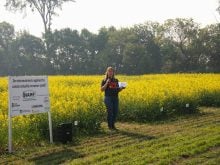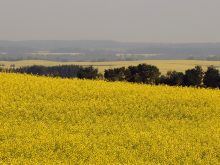SASKATOON — One of Canada’s top competitors in the canola export market is having trouble with its crop this year.
Ukraine’s canola is a winter crop that is planted in the September/October period and harvested in the July/August period.
Argus media is forecasting the country’s final harvested area at 3.41 million acres, down five per cent from last year.
Read Also

Government, industry seek canola tariff resolution
Governments and industry continue to discuss how best to deal with Chinese tariffs on Canadian agricultural products, particularly canola.
But that number could drop further due to farmers replanting the crop to corn in the Poltava region and with sunflower in the southern and Dnipro regions.
“It has been too dry for rapeseed, although a lot of rain is forecast for the next two weeks, so it could improve conditions,” Anna Sneidermane, Argus’s deputy editor of agriculture, said in an email.
Argus’s official forecast for Ukraine’s 2025-26 canola crop calls for 3.9 million tonnes of production down from four million tonnes in the current marketing year.
“But we are reviewing this forecast and are likely to cut it further,” said Sneidermane.
Exports are currently pegged at 3.5 million tonnes, up from 3.4 million.
The country is coming off a poor crop in 2024 where production fell by 20 per cent compared to the previous year, according to a recent article written by UkrAgroConsult oilseed market analyst Svitlana Kupreeva.
So, it looks like there could be back-to-back poor crops in Ukraine.
Dry weather has also increased risks for Russia’s winter rapeseed, which means farmers are likely to switch some acres to spring rapeseed.
“For Russia’s winter rapeseed, there will likely be more losses than in Ukraine,” said Sneidermane.
“It was drier during planting, and some fields did not emerge at all. Others are now underdeveloped, and some are in the flowering stage now, so at risk from the incoming cold snap.”
Despite the challenges, Argus still expects Russian farmers to produce 4.8 million tonnes of the crop in 2025-26 as farmers opt to plant more spring rapeseed. That compares to five million tonnes last year.
Sneidermane is forecasting 700,000 tonnes of exports, down from 910,000 tonnes in the current marketing campaign.
“Russia crushes the majority of its production domestically,” she said.
Australia is Canada’s other main competitor in export markets.
That country’s canola production fell by two per cent to 5.9 million tonnes in 2024-25, as a decrease in planted area offset higher yields, according to the government’s March 2025 crop report.
It is the fourth largest canola crop on record.
Production is down compared to last year but is 31 per cent about the 10-year average. Canola is typically planted in the March to May period and harvested from October to December.
The U.S. Department of Agriculture’s Foreign Agricultural Service (FAS) is forecasting a 3.5 per cent increase in Australia’s canola production for the crop year ahead due to higher harvested area and yields.
If realized, the 6.15 million tonne crop would be the third largest on record.
The FAS does not think that Canada’s tariff woes will have much of an impact on Australia’s overall planted area, but it could lead to a shift towards increased planting of non-GM canola due to its “substantially increased premium.”
Eastern Australia received beneficial rainfall in mid-February, except for South Australia and northwestern Victoria, which remain drier than normal.
Additional rainfall in March improved conditions in Western Australia and much of the east, except for South Australia and northwestern Victoria.
“These rains have built some grower confidence in the lead-up to the 2025-26 season,” the FAS stated in its April 2nd report.
The Australian Bureau of Meteorology is forecasting near-average rainfall from April to June 2025, which is the critical planting and growth period.
“Encouragingly, South Australia — the region most in need of rain — has a more favourable rainfall outlook than other canola-producing areas,” said the FAS.
The FAS’s yield forecast is 5.7 per cent below the five-year average due to below-average soil moisture levels, although it is better than the same time last year.
Australia’s canola exports for 2025-26 are forecast at 4.65 million tonnes, a 200,000 tonne decrease from the current year due to a 200,000 tonne increase in domestic crush to 1.3 million tonnes.
Australia is the world’s second biggest canola exporter behind Canada. The European Union accounts for 40 per cent of Australia’s exports, down from 90 per cent a decade ago.
“Substantial diversification has been away from the EU toward Japan, the United Arab Emirates, Pakistan and Mexico,” said the FAS.
The Australian dollar has depreciated considerably since the end of 2024, reaching its lowest levels since late 2022. That has increased the competitiveness of Australian canola seed, oil and meal in export markets.
Australia’s ending stocks for 2025-26 are forecast at 420,000 tonnes, up from 343,000 tonnes in the current marketing year.
Sales of Australian canola to the EU have been strong of late due to decreased competition from Ukraine.
The European Commission (EC) is forecasting 18.99 million tonnes of EU rapeseed production in 2025-26.
That would be a big rebound from the 16.89 million tonnes produced last year, although below the 19.74 million tonnes harvested in 2023-24.
EU rapeseed is primarily a winter crop, and those crops are “off to a promising start,” according to the EC’s Joint Research Centre.
“However, more rainfall is needed in central and eastern Europe to sustain the good yield potential,” the EC stated in its latest JRC MARS Bulletin.
Winter crops in western Romania and Bulgaria are suffering from limited water availability since the start of the season.
It also noted that limited precipitation has prevented any crop recovery from poor conditions during plant emergence in eastern Ukraine.
“The lack of snow cover and expected colder-than-usual conditions raise additional concerns,” JRC stated in its March 24th bulletin.
“In other parts of central and eastern Europe, crops are mostly in good condition, but rainfall is imminently needed as winter crops restart growing.”
EU rapeseed imports for 2025-26 are forecast at 5.78 million tonnes, down slightly from the 5.83 million tonnes estimated for the current crop year.
The USDA’s FAS is forecasting 18.46 million tonnes of Canadian canola production in 2025-26, up from its forecast of 17.85 million tonnes for the current marketing campaign.
It expects increased planting of the crop due to low stocks relative to previous years and high prices relative to other commodities.
The FAS is assuming yields will also increase due to better soil moisture conditions.
It is forecasting 6.5 million tonnes of seed exports, down from 7.3 million tonnes in the current campaign based on lower total seed supply and increased domestic crush capacity.
The FAS report notes that Canada’s crush capacity will increase to 14.46 million tonnes by the end of 2025 compared to 13.46 million tonnes at the end of 2024 due to completion of Cargill’s new facility in Regina in the fall of 2025.


















